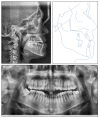Skeletal Class III Malocclusion with Lateral Open Bite and Facial Asymmetry Treated with Asymmetric Lower Molar Extraction and Lingual Appliance: A Case Report
- PMID: 34070132
- PMCID: PMC8158363
- DOI: 10.3390/ijerph18105381
Skeletal Class III Malocclusion with Lateral Open Bite and Facial Asymmetry Treated with Asymmetric Lower Molar Extraction and Lingual Appliance: A Case Report
Abstract
A skeletal Class III malocclusion with open bite tendency is considered very difficult to treat orthodontically without surgery. This case report describes the lingual orthodontic treatment of an adult skeletal Class III patient with mandibular deviation to the left side, lateral open bite, unilateral posterior crossbite, zero overbite and negative overjet. The lower incisors were already retroclined to compensate with the skeletal discrepancy. The patient was treated by asymmetric molar extraction in the mandibular arch to retract the lower incisors and correct the dental midline, with the help of intermaxillary elastics. Lingual appliance was used with over-torqued lower anterior teeth's brackets to control the torque of mandibular incisors. After a 30-month treatment, satisfactory smile and facial esthetics and good occlusion was achieved. A 12-month follow-up confirmed that the outcome was stable. Asymmetric molar extraction could be a viable option to retract mandibular incisors in Class III malocclusion with lower dental midline deviation.
Keywords: lateral open bite; lingual orthodontics; mandibular lateral deviation; molar extraction; skeletal class III malocclusion.
Conflict of interest statement
The authors declare no conflict of interest.
Figures












Similar articles
-
Severe unilateral scissors-bite with a constricted mandibular arch: Bite turbos and extra-alveolar bone screws in the infrazygomatic crests and mandibular buccal shelf.Am J Orthod Dentofacial Orthop. 2018 Oct;154(4):554-569. doi: 10.1016/j.ajodo.2017.03.032. Am J Orthod Dentofacial Orthop. 2018. PMID: 30268266
-
Severe Open Bite Correction and 5-mm Mandibular Arch Distalisation without Skeletal Anchorage: 4-year Follow-up of a Case of Nonsurgical Orthodontic Treatment of Adult Skeletal Class III Malocclusion.Chin J Dent Res. 2020;23(4):297-307. doi: 10.3290/j.cjdr.b867899. Chin J Dent Res. 2020. PMID: 33491362
-
Multidisciplinary treatment with a customized lingual appliance for an adult patient with severe Class III malocclusion and multiple missing teeth.Am J Orthod Dentofacial Orthop. 2019 Sep;156(3):401-411. doi: 10.1016/j.ajodo.2019.05.004. Am J Orthod Dentofacial Orthop. 2019. PMID: 31474270
-
Substantial Improvements in Facial Morphology through Surgical-Orthodontic Treatment: A Case Report and Literature Review.Medicina (Kaunas). 2022 Aug 3;58(8):1043. doi: 10.3390/medicina58081043. Medicina (Kaunas). 2022. PMID: 36013510 Free PMC article. Review.
-
Occlusal Disorders in Patients with Sickle Cell Disease: Critical Literature Review.J Clin Pediatr Dent. 2021 Apr 1;45(2):117-122. doi: 10.17796/1053-4625-45.2.8. J Clin Pediatr Dent. 2021. PMID: 33951171 Review.
Cited by
-
Management of anterior and posterior crossbites with lingual appliances and miniscrew-assisted rapid palatal expansion: A case report.Medicine (Baltimore). 2024 Dec 6;103(49):e40832. doi: 10.1097/MD.0000000000040832. Medicine (Baltimore). 2024. PMID: 39654233 Free PMC article.
-
Soft and hard tissue changes after compensatory treatment in skeletal class III malocclusion.PLoS One. 2025 May 7;20(5):e0322551. doi: 10.1371/journal.pone.0322551. eCollection 2025. PLoS One. 2025. PMID: 40333773 Free PMC article.
-
3D-printed indirect bonding trays and transfer jigs for lingual brackets: Digital workflows and two case reports.Heliyon. 2024 May 28;10(11):e32035. doi: 10.1016/j.heliyon.2024.e32035. eCollection 2024 Jun 15. Heliyon. 2024. PMID: 38867963 Free PMC article.
-
Multidisciplinary management of skeletal class III malocclusion with unilateral condylar hyperplasia and missing mandibular first molar: a case report.BMC Oral Health. 2025 Jul 1;25(1):976. doi: 10.1186/s12903-025-06346-y. BMC Oral Health. 2025. PMID: 40598029 Free PMC article.
-
Nonsurgical treatment of an adult with skeletal Class III malocclusion, posterior crossbite and mandibular asymmetry.J Clin Exp Dent. 2023 Nov 1;15(11):e978-e983. doi: 10.4317/jced.60939. eCollection 2023 Nov. J Clin Exp Dent. 2023. PMID: 38074163 Free PMC article.
References
-
- Antelo O.M., Meira T.M., Oliveira D.D., Pithon M.M., Tanaka O.M. Long-term stability of a Class III malocclusion with severe anterior open bite and bilateral posterior crossbite in a hyperdivergent patient. Am. J. Orthod. Dentofac. Orthop. 2020;157:408–421. doi: 10.1016/j.ajodo.2018.10.029. - DOI - PubMed
-
- Huang G.J. Long-term stability of anterior open-bitetherapy: A review. Semin. Orthod. 2002;8:162–172. doi: 10.1053/sodo.2002.125436. - DOI
Publication types
MeSH terms
LinkOut - more resources
Full Text Sources

